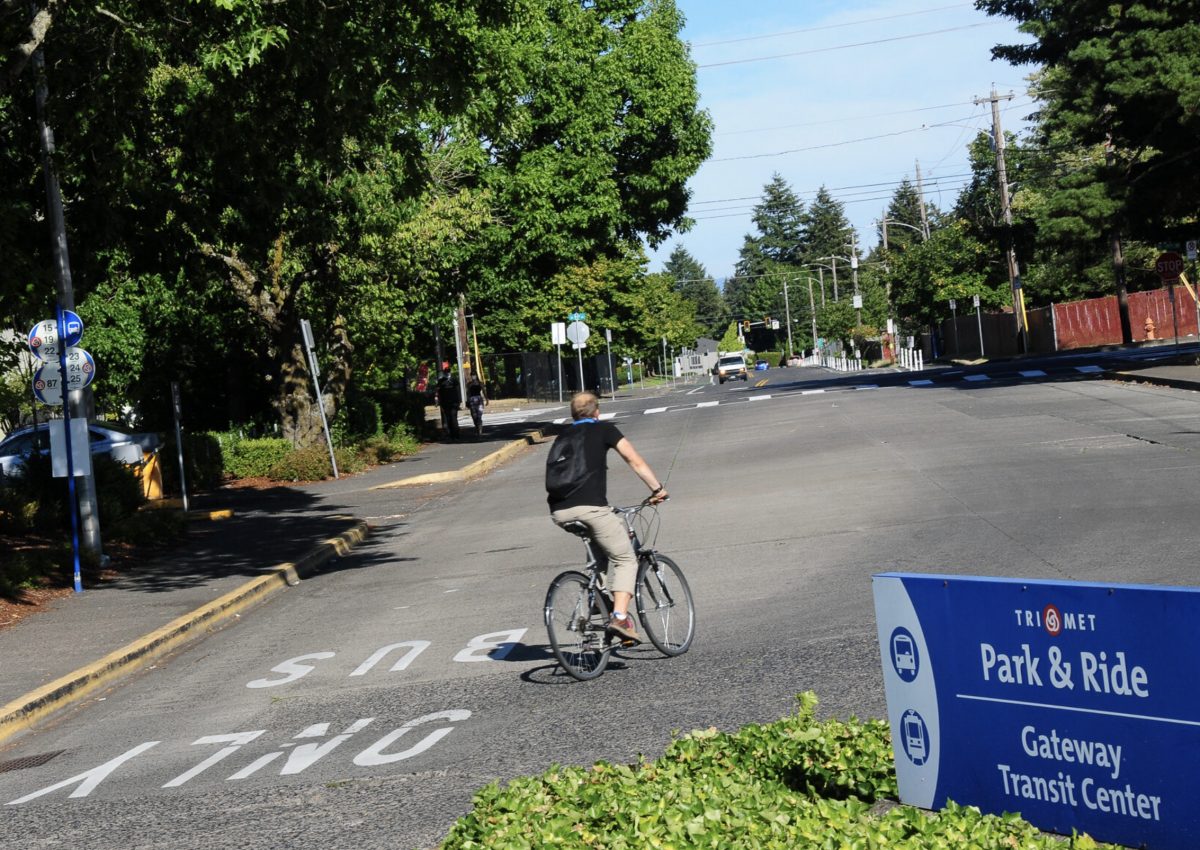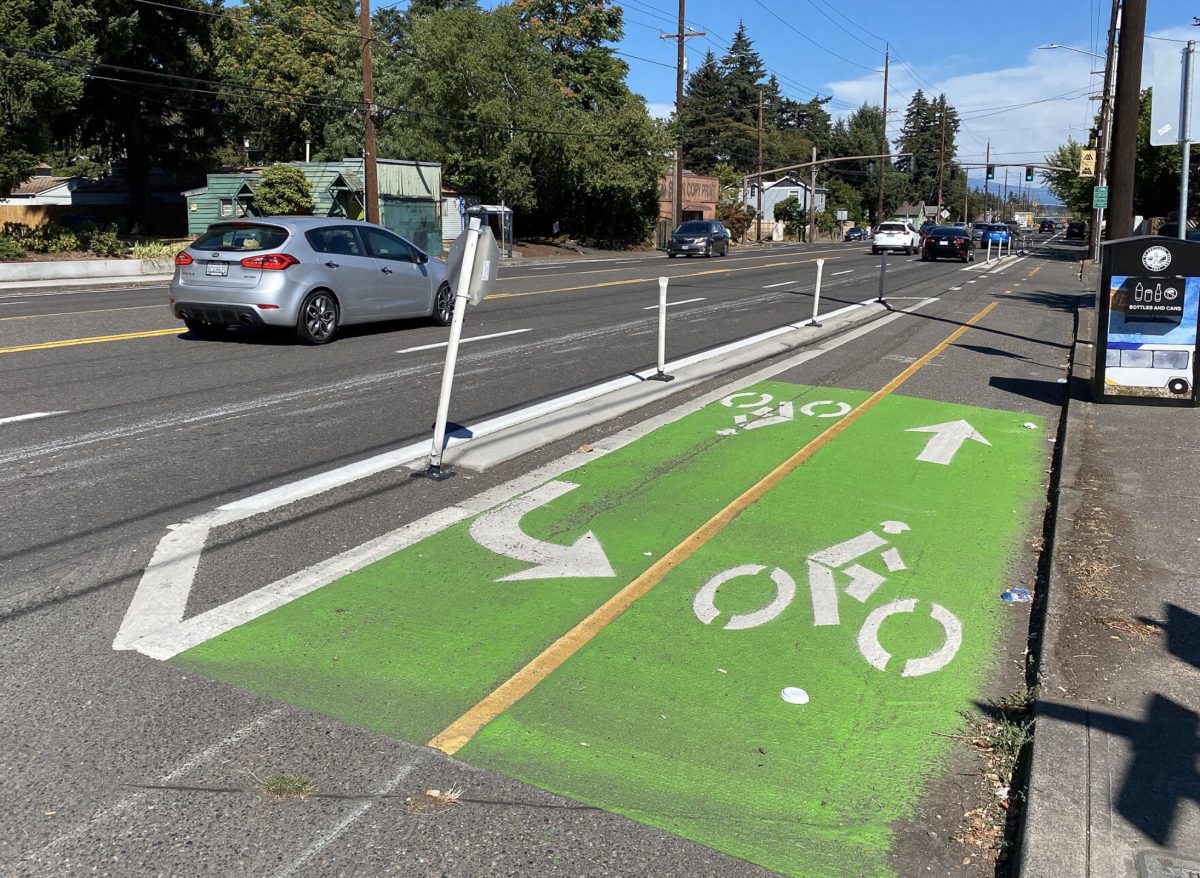
(Photos: Jonathan Maus/BikePortland)
The Portland Bureau of Transportation recently put the finishing touches on two new neighborhood greenways in east Portland. Known as the “130s” and the “HOP,” the projects add nearly seven miles of “low-stress, family-friendly” bike routes to a part of town that desperately needs them.
I rode both of them last week to get a closer look.
The 130s
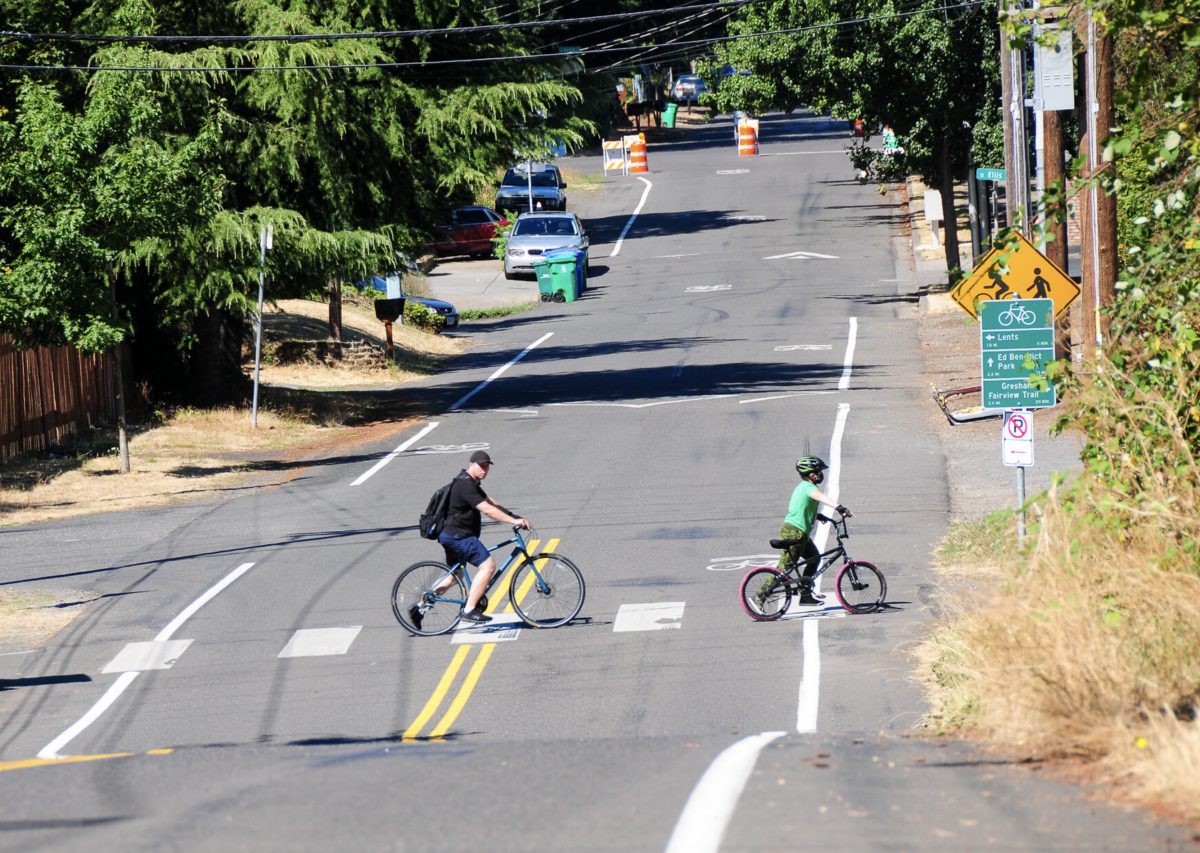
The 130s is so named because it follows a north-south route that generally stays within a few blocks of 130th (if you’re new here, this naming convention applies to lots of greenways). It starts at SE Foster Road and goes about five miles north to I-84. PBOT began construction in summer 2019 and just finished up this year. The route alternates between 128th, 129th, 130th, and 132nd — all of which have been updated with speed bumps, 20 mph signs, sharrows, crossing upgrades at major streets, and so on.
I started on the 130s at 128th where it meets the Springwater Corridor path where the land-use is classic Portland suburban/rural with no sidewalks and low traffic volumes. Things were calm until I got to SE Holgate where there’s a jog over to 130th. To make the crossing a bit safer, PBOT added a buffer to the bike lane and installed crosswalks (see below). Even though Holgate is narrow and has just one lane for drivers in each direction, people still drive too fast. It would be great if greenway crossings always came with some sort of traffic calming on the larger streets.

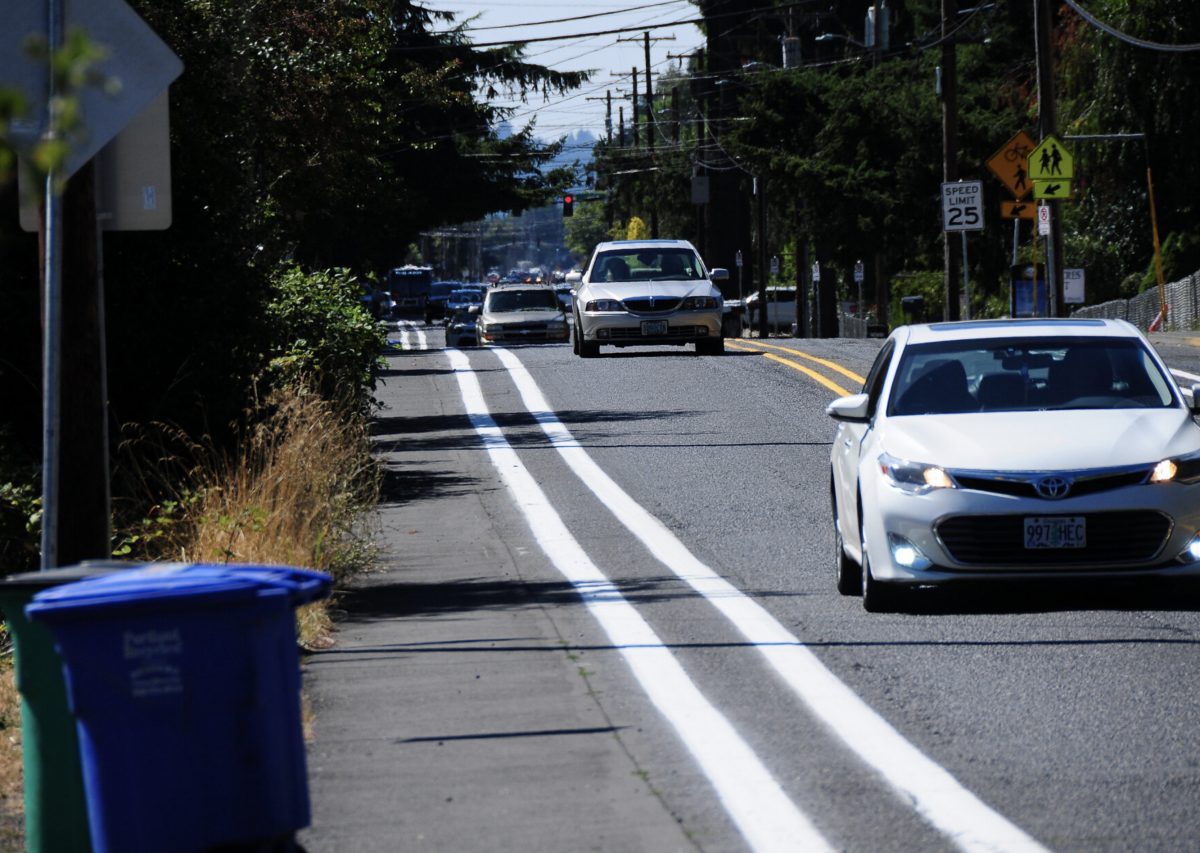
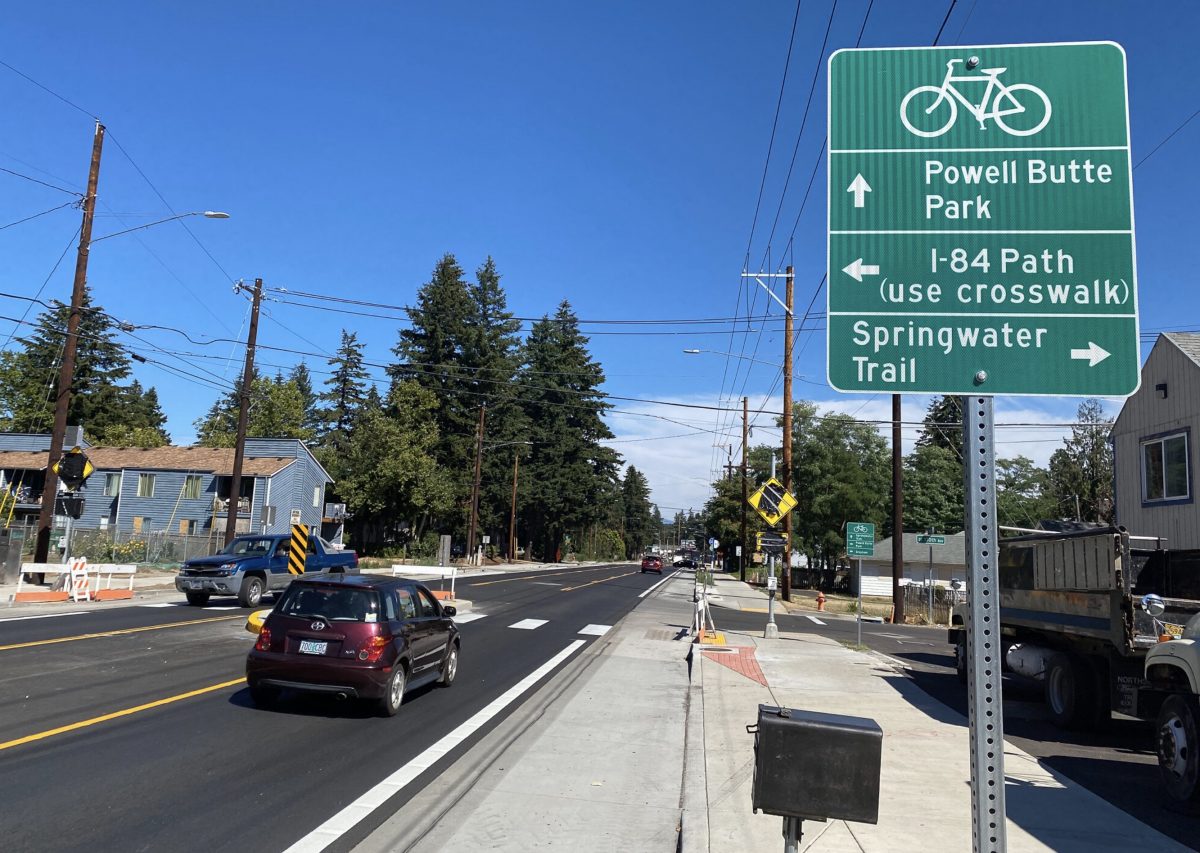
The next big crossing was SE Powell (Hwy 26) where the route jogs a block west to 129th. Riding northbound there’s a new signalized (flashing beacon) crosswalk and median that leads to a protected bike lane on the north side of Powell. If you were riding southbound, I think the idea is to go east on a new path paved next to the sidewalk on the north side, then use the new signal. ODOT is working on their Outer Powell Safety Project in this same area so we’ll soon have protected bike lanes which should make this crossing even better.
Advertisement


At Division the route jogs east back to 130th. Division is wide and sketchy arterial with multiple traffic lanes. To facilitate the bike crossing PBOT has built a two-way protected bike lane on the south side. The lanes are protected by a concrete curb, buffer striping, green coloring, plastic wands, and reflectors. Even so, being surrounded by so many loud and fast drivers raises my stress level quite a bit.




Between Stark and Division PBOT has installed “fire-friendly” speed bumps, owing to its designation as a first-responder route. These bumps have four large grooves intended for tires of fire trucks and ambulances. As I’ve documented previously, I don’t like these. The majority of drivers illegally swerve into the grooves, which means they can avoid slowing down and they put themselves (and others) at risk for collisions. The bumps also go well into the bike lane which creates a bump for riders (who don’t need it) next to a gutter which collects debris.
Advertisement




At Stark the route once again makes a jog west to 129th and PBOT has created a two-way facility to help make it happen more safely. This time they’ve decided to route southbound bicycle riders onto a sidewalk between 129th and 130th where there’s a new crosswalk and signal. Northbound this isn’t too big of a deal since Stark has a buffered bike lane (why all these buffered lanes don’t have physical protection is a mystery to me!). But southbound, getting onto the sidewalk requires riders to cross in front of drivers turning off Stark northbound on 129th. This could lead to a collision. The sidewalk route itself is not ideal. PBOT has placed little green pavement markers to help guide the way, but the sidewalk is narrow and you’ll be sharing the space with others.




Continuing northbound I came to Burnside, which requires another one-block jog east to get to 128th. Since Burnside also has a MAX light rail in the middle of it, this crossing very constrained. The route took me onto the sidewalk following those green dots again and then directed me over the rail tracks via a narrow sidewalk hemmed in by railings. These tight corners will be difficult and/or impossible for people riding large cargo bikes or pulling trailers.

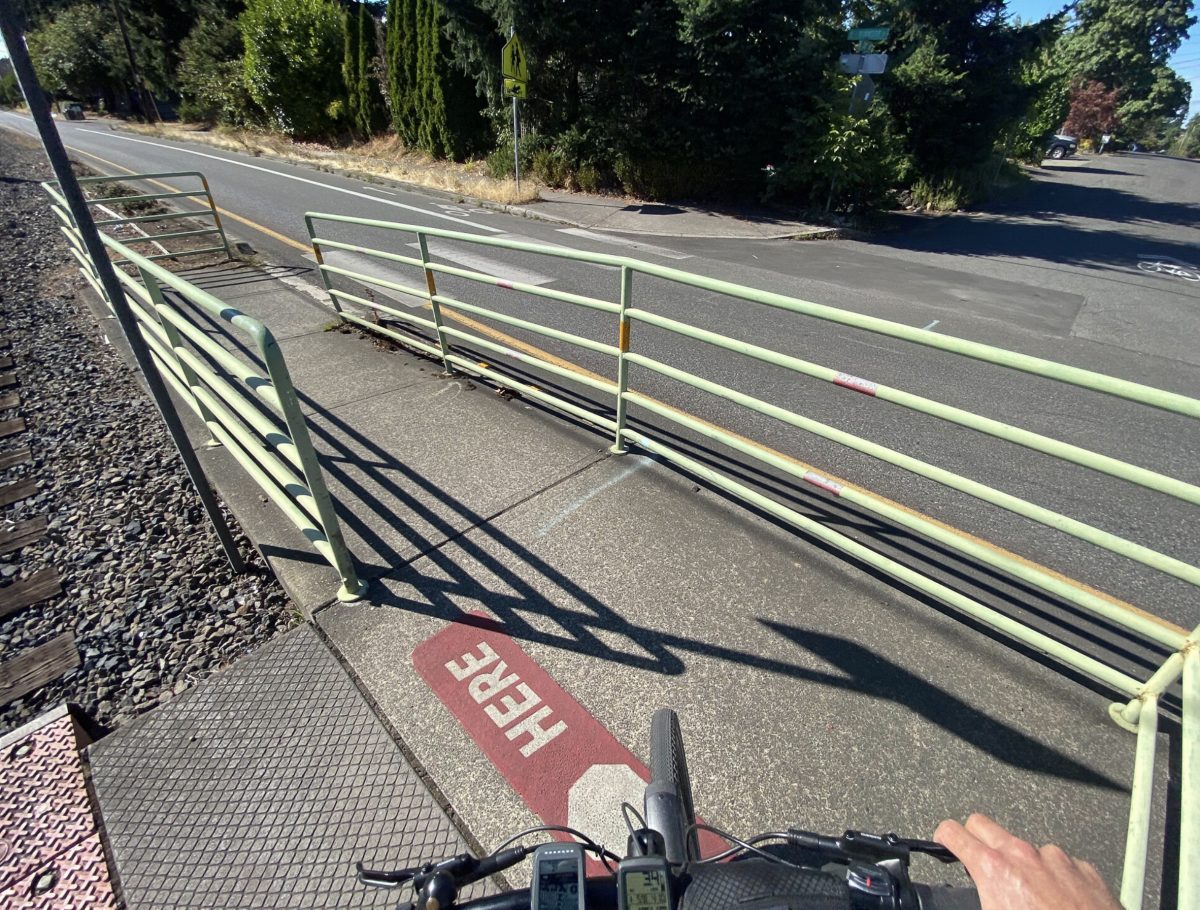
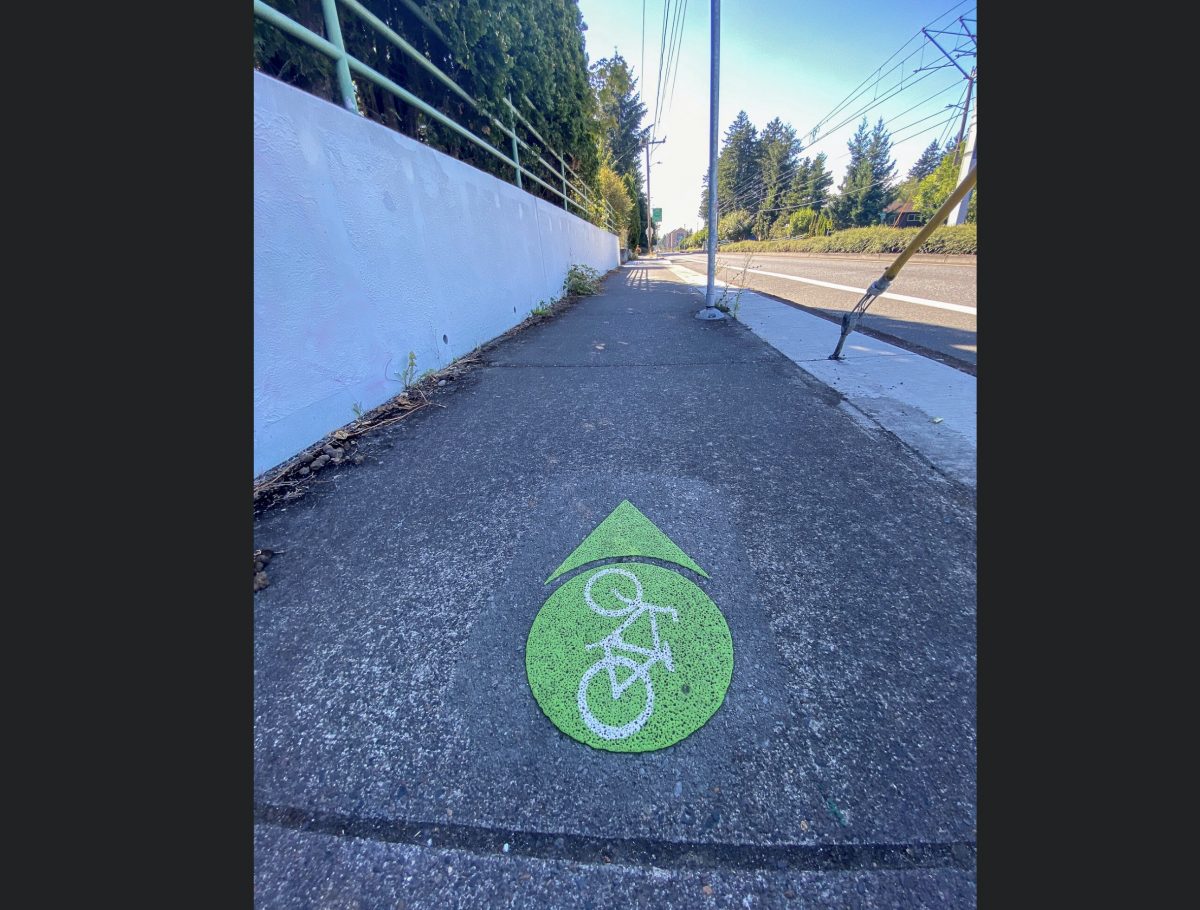

The next crossing I came to was at Glisan near Menlo Park Elementary. I shared a preview of this project when it was built last year. With two-way protected bike lanes on both sides of the street, and a flashing beacon crossing built right in front of the school, this is one the most thoroughly designed and capital-intensive bike crossings in Portland. It works well and feels safe, but it feels a bit ahead of its time — given the low cycling rates in this neighborhood and with the school being so quiet these days.
Advertisement




Let’s go to the HOP
North of Glisan I connected to the new HOP neighborhood greenway and headed west. The HOP stands for Hassalo/Holladay-Oregon-Pacific, the three streets that a new, $1.5 million greenway relies on to get from Glendoveer Golf Course in the Hazelwood neighborhood to the Gateway Transit Center at I-205.
The residential street portions of this new route are chill and calm and aren’t worth discussing here — except for two newly paved sections. As part of this project PBOT laid down fresh pavement where there used to be gravel and potholes on NE Oregon between 110th and 111th and NE Holladay between 118th and 119th. I’ll focus my report on the two major arterial crossings and the connection to the transit center.

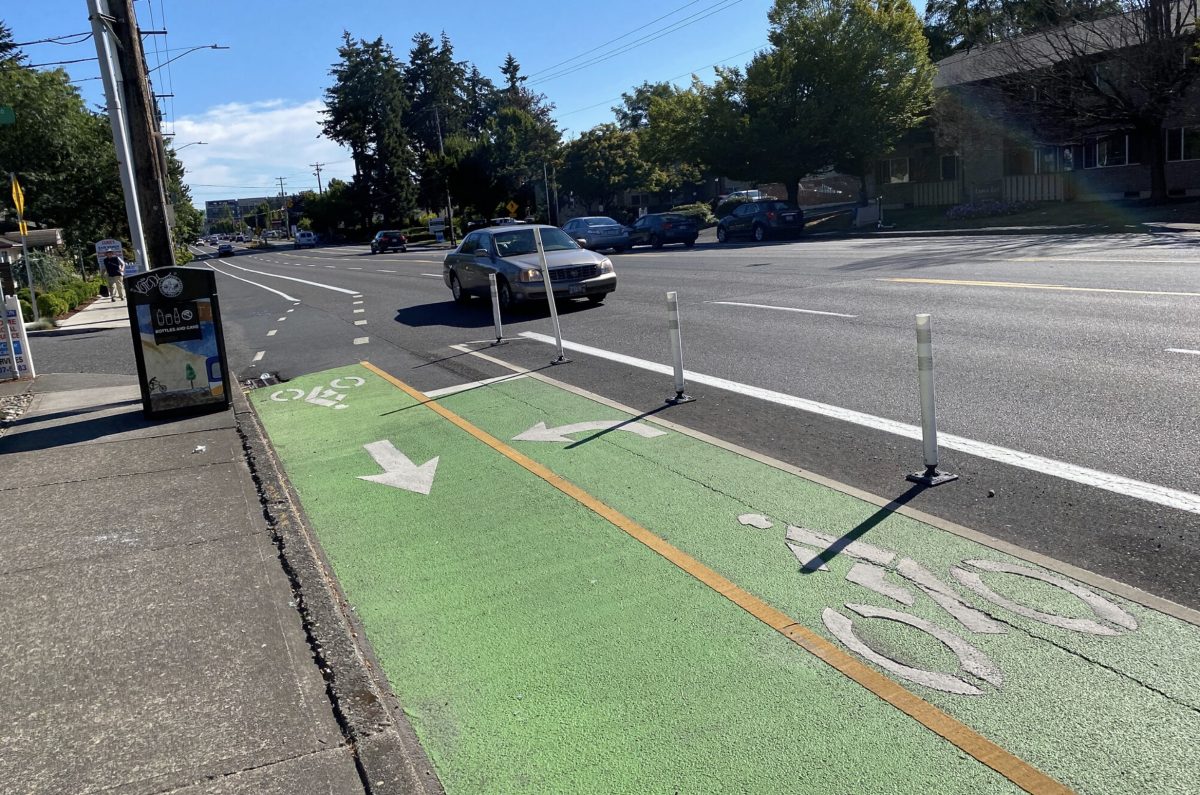




At NE 122nd PBOT needed to create a safer crossing to keep people on the route because NE Holladay is off-set by about 250 feet. Their solution is another two-way protected bike lane and a new crossing with a flashing beacon. Riding westbound it was easy to roll into the new protected space. At the crosswalk there’s a button-activated flashing beacon and a cross-bike that worked like it was supposed to (the people stopped for me immediately). Coming from the east to cross 122nd, I had to cross oncoming traffic to get up onto a new bike-only sidewalk that positioned me at the new crossing.

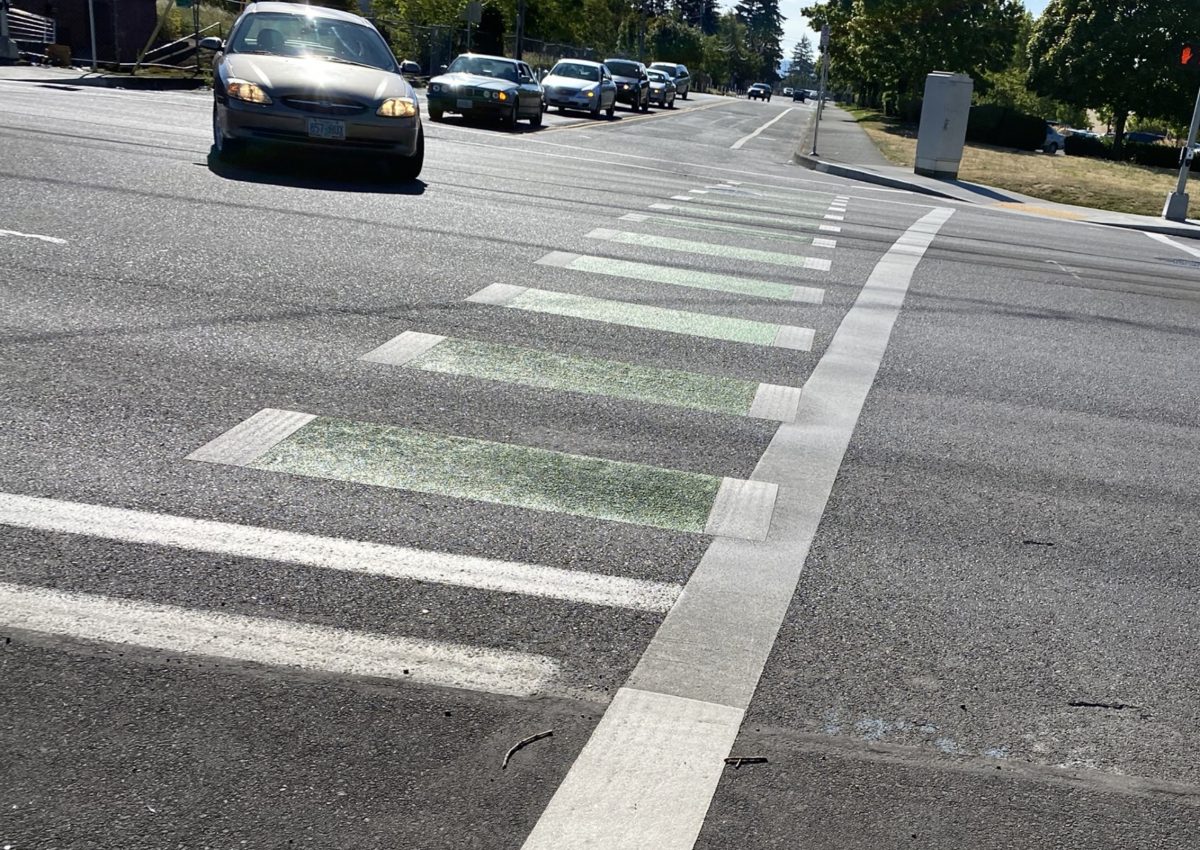


The next big arterial I had to deal with on the HOP was 102nd Avenue. The route at this point had me on NE Pacific and I faced another off-set crossing situation. PBOT handled this one a bit differently (the lack of consistency is problematic). Heading west from Pacific, I took an unprotected bike lane with a buffer northbound and then was routed up onto the sidewalk to get into position for the signalized crossing. For people going eastbound on the HOP at Pacific and 102nd, PBOT routes the greenway to a new bikeway built on the eastern sidewalk.
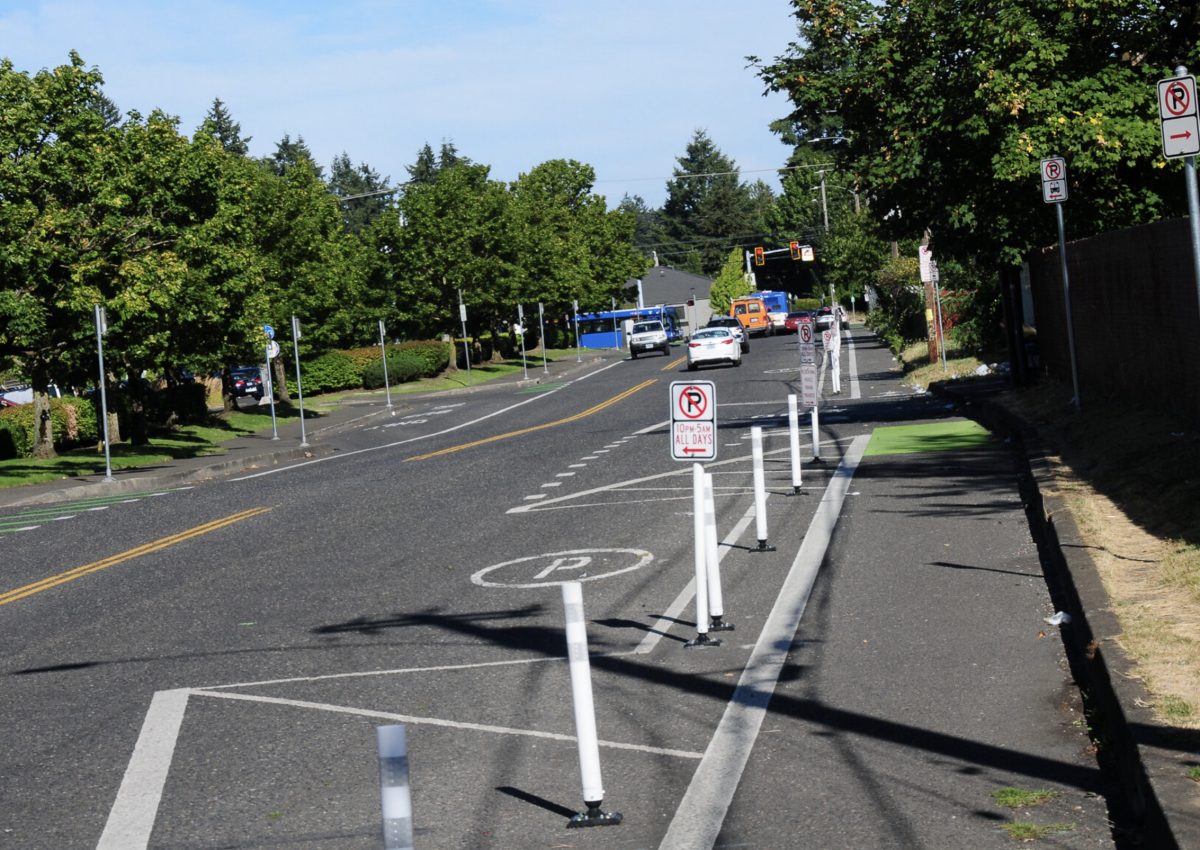
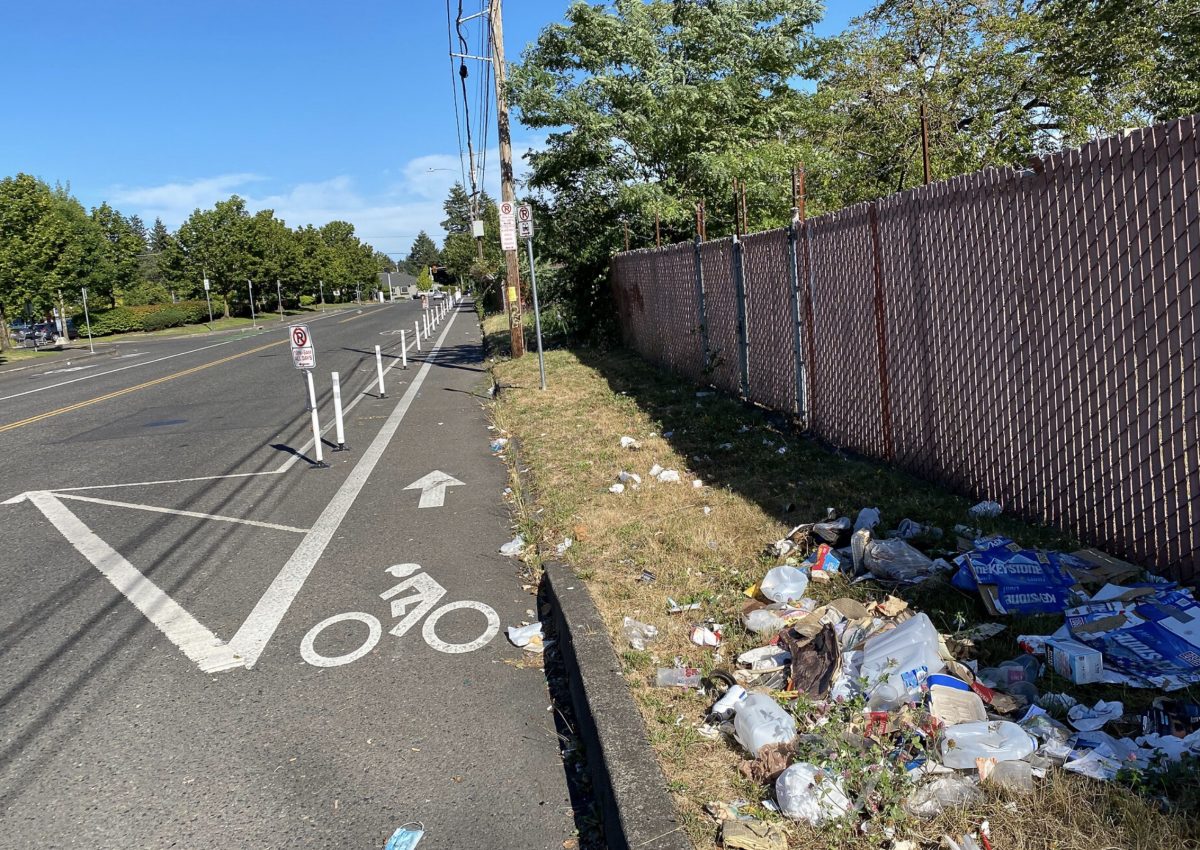
The last section of the HOP took me directly to the Gateway Transit center where I could connect to bus/MAX or get onto the I-205 path. To help make this connection, PBOT has added an unprotected bike lane for westbound traffic (adjacent to the shopping center) and a parking protected, curbside bike lane eastbound.
Advertisement
I found the eastern end of the HOP disappointing. I didn’t find any clear connection to the transit center itself. I mean, this is a major transit center and the bikeway just seemed to fizzle out. I didn’t see any clear signage and there certainly wasn’t a protected space that got me all the way to a place to park my bike and get onto transit. Also, the eastbound bikeway to 102nd was littered with debris and overgrown vegetation. It makes no sense to invest in a new bikeway if we don’t make it great at the connections!
Takeaways
Overall, it’s fantastic to have these greenways completed. East Portlanders have been waiting a very long time. The lack of street grid and high speed of drivers makes every bike network investment important out there. While I focused on the crossings, what’s really great about these new greenways is how they will help people find their way between neighborhoods. I love knowing that no matter where I’m at in the city, if I’m on a road with sharrows and speed bumps, I know it’s the safest route to be on — and that it will connect me to another route. I can get across the entire city simply by following the sharrow breadcrumbs.
The lack of consistency in the treatments and all the sidewalk routing is troubling (and it’s not limited to these two projects). There’s a lot of non-intuitive bike traffic movements that people in cars and on bikes will have to get used to. That learning curve makes me nervous because it could result in a lack of enthusiasm for riding or more risk for those who do it.
And finally, we must do more to tame high-speed traffic on arterials. PBOT is making strides here (they just got approval to lower the speed limit on 102nd), but they’re not moving fast enough. It doesn’t matter how good our low-stress greenways are if the crossings are high-stress. A chain is only as strong as its weakest link, remember?
Get out there and try these new greenways. I’d love to know what you think.
(P.S. If you follow BikePortland on Instagram you got the first-person video version of this report already! I plan to do more of those, so stay tuned.)
— Jonathan Maus: (503) 706-8804, @jonathan_maus on Twitter and jonathan@bikeportland.org
— Get our headlines delivered to your inbox.
— Support this independent community media outlet with a one-time contribution or monthly subscription.



